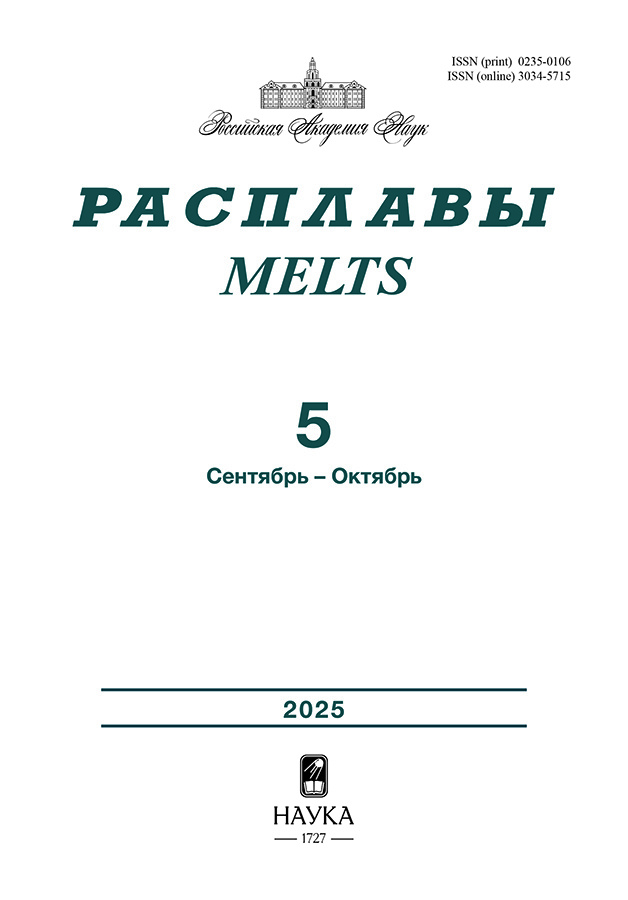Поверхностное натяжение и плотность расплавов индий–олово и их зависимость от состава и температуры
- Авторы: Дадашев Р.Х.1,2, Кутуев Р.А.1,3, Элимханов Д.З.3
-
Учреждения:
- Чеченский государственный университет им. А.А. Кадырова
- Комплексный научно-исследовательский институт им. Х.И. Ибрагимова
- Академия наук Чеченской Республики
- Выпуск: № 1 (2023)
- Страницы: 78-88
- Раздел: Статьи
- URL: https://kazanmedjournal.ru/0235-0106/article/view/661329
- DOI: https://doi.org/10.31857/S0235010623010024
- EDN: https://elibrary.ru/HIKJRG
- ID: 661329
Цитировать
Полный текст
Аннотация
В работе представлены результаты измерения поверхностного натяжения (σ) и плотности (ρ) расплавов индий–олово. Измерения σ и ρ проведены разными методами. Поверхностное натяжение измерено методом лежащей капли и максимального давления в капле, а плотность – ареометром и методами лежащей капли. Для исследований использованы металлы высокой чистоты In-00, олово – ОВЧ. Максимальная ошибка измерения σ равна 0.8%, а ρ – 0.2%. Зависимость σ расплавов In–Sn от состава характеризуется экстремумом (пологим минимумом) в области эквимолярного состава. С ростом температуры глубина минимума уменьшается, его положение смещается в сторону чистого индия. Молярные объемы имеют небольшие положительные отклонения от аддитивных значений. С увеличением температуры молярные объемы приближаются к аддитивным величинам. Методом лежащей капли были измерены температурные зависимости σ и ρ разбавленных по индию растворов In–Sn. Показано, что добавки индия понижают поверхностное натяжения олова. С учетом того, что значение поверхностного натяжения индия выше, чем у олова, такой результат свидетельствует о том, что изотермы поверхностного натяжения системы индий-олово должны пройти через минимум.
Ключевые слова
Об авторах
Р. Х. Дадашев
Чеченский государственный университет им. А.А. Кадырова; Комплексный научно-исследовательский институт им. Х.И. Ибрагимова
Автор, ответственный за переписку.
Email: edzhabrail@mail.ru
Россия, Грозный; Россия, Грозный
Р. А. Кутуев
Чеченский государственный университет им. А.А. Кадырова; Академия наук Чеченской Республики
Email: edzhabrail@mail.ru
Россия, Грозный; Россия, Грозный
Д. З. Элимханов
Академия наук Чеченской Республики
Email: edzhabrail@mail.ru
Россия, Грозный
Список литературы
- Субботин В.И. Жидкометаллические носители в ядерной энергетике // В сб.: Материалы докладов Российской межотраслевой конференции “Тепломассообмен и свойства жидких металлов”. Обнинск: ФЭИ, 2002. 1. С. 15–16.
- Дадашев Р.Х., Кутуев Р.А., Созаев В.А. Поверхностные свойства сплавов на основе свинца, олова, индия, кадмия. М.: Физматлит, 2016.
- Keene B.J. The surface tension of tin and its alloys with particular reference to solders, DMM(A) 113, National Physical Laboratory Teddington, 1993. P. 131.
- Кононенко В.Н., Яценко С.И., Сухман Л.Я. Поверхностные свойства сплавов. In–Ga и In–Sn // ЖФХ. 1972. 46. С. 1589–1590.
- Tanaka T. et al. Measurement of surface tension of liquid Ga-base alloys by a sessile drop method // Z. Metallkd. 2001. 92. P. 1242–1246.
- Predel B., Eman A. Die Volumenanderung bei der bildung flussiger legierungen des systems Ga–Sn, Ga–In, In–Bi, In–Pb, In–Sn und In–Tl // I. Less-Common Metals. 1969. 18. P. 385–397.
- Ковальчук В.Ф., Кузнецов Б.А. Поверхностное натяжение сплавов индий-олово и таллий-свинец // Поверхностные явления в расплавах. Киев: Наукова думка. 1968. С. 187–191.
- Ибрагимов Х.И., Дадашев Р.Х. Комбинированный прибор для измерения поверхностного натяжения, работы выхода электрона и плотности жидких металлов и сплавов // К изучению поверхностных явлений в металлических расплавах. Орджоникидзе: Изд-во СOГУ, 1989. С. 68–71.
- Шебзухов А.А., Ашхотов О.Г. Исследование ближнего порядка на поверхности жидких растворов индий–галлий и индий–олово // Доклады Академии наук СССР. 1984. 274. № 6. С. 1427.
- Guo Z., Hindler M., Yuan W., Mikula A. The density and surface tension of In–Sn and Cu–In–Sn alloys Monatsh // Chem. 2011. 142. P. 579–584.
- Z. Moser W. Gaşior J. Pstrús. I. Kaban W. Hoyer thermophysical properties of liquid In–Sn alloys // Int. J. Thermophys. 2009. 30. P. 1811–1822.
- Novakovic R., Giuranno D., Ricci E., Lanata T. Surface and transport properties of In–Sn liquid alloys // Surface Science. 2008. 602. P. 1957–1963.
- Liu X.J., Inohana, Y., Takaku, Y., Ohnuma, I., Kainuma R., Ishida K., Moser Z., Gasior W., Pstrus J. Experimental determination and thermodynamic calculation of the phase equilibria and surface tension in the Sn–Ag–In system // J. Electronic Materials. 2002. 31. № 11. P. 1139–1151.
- Lee B.J., Oh C.S., Shim J.S. Thermodynamic assessments of the Sn-In and Sn-Bi binary systems // J. Electronic Materials. 1996. 25. № 6. P. 983–991.
- Дадашев Р.Х. Термодинамика поверхностных явлений. 2-е изд. испр. М.: ФИЗМАТЛИТ, 2008.
- Ибрагимов Х.И., Покровский Н.Л., Пугачевич П.П. О некоторых методических вопросах измерения поверхностного натяжения металлических расплавов // Поверхностные явления в расплавах и возникающих из них твердых фазах. Нальчик: КБГУ. 1965. С. 198–210.
- Ибрагимов Х.И., Саввин B.C. Приборы для совместного измерения плотности, поверхностного натяжения и работы выхода электрона жидких металлических растворов // Методы исследования и свойства границ раздела контактирующих фаз. Киев: Наукова думка, 1977. С. 40–46.
- Дадашев Р.Х., Ибрагимов Х.И., Юшаев С.М. Поверхностные свойства расплавов индий-олово и таллий-висмут // Изв. вузов. Цветная металлургия. 1984. № 1. С. 121–122.
- Дадашев Р.Х., Алчагиров Б.Б., Элимханов Д.З., Талхигова Х.С., Дадашева З.И. Температурная зависимость поверхностного натяжения эвтектического сплава // Вестник Тамбовского государственного технического университета. 2020. 26. № 1. С. 124–132.
Дополнительные файлы












